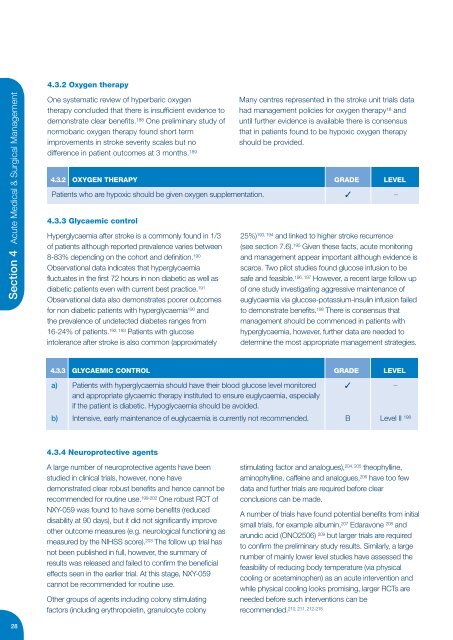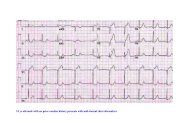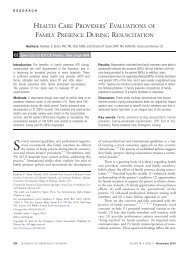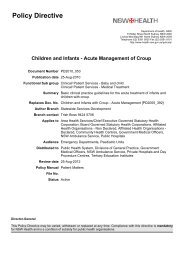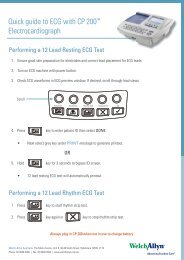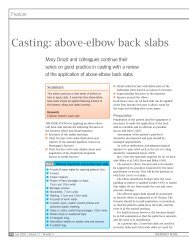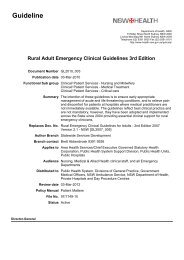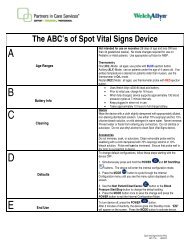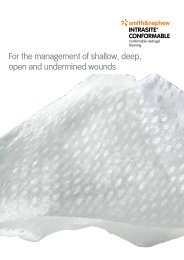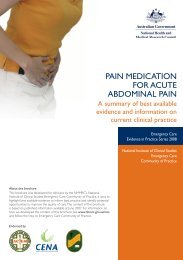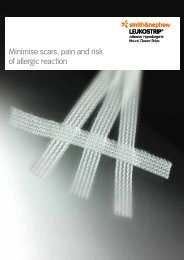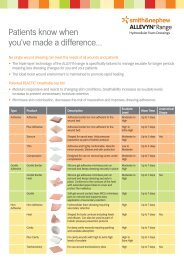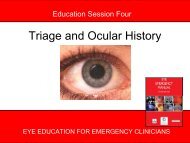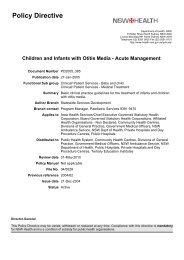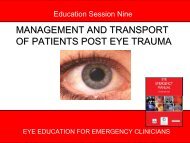Clinical Guidelines for Acute Stroke Management - Living on the EDge
Clinical Guidelines for Acute Stroke Management - Living on the EDge
Clinical Guidelines for Acute Stroke Management - Living on the EDge
Create successful ePaper yourself
Turn your PDF publications into a flip-book with our unique Google optimized e-Paper software.
4.3.2 Oxygen <strong>the</strong>rapy<br />
Secti<strong>on</strong> 4 <str<strong>on</strong>g>Acute</str<strong>on</strong>g> Medical & Surgical <str<strong>on</strong>g>Management</str<strong>on</strong>g><br />
One systematic review of hyperbaric oxygen<br />
<strong>the</strong>rapy c<strong>on</strong>cluded that <strong>the</strong>re is insufficient evidence to<br />
dem<strong>on</strong>strate clear benefits. 188 One preliminary study of<br />
normobaric oxygen <strong>the</strong>rapy found short term<br />
improvements in stroke severity scales but no<br />
difference in patient outcomes at 3 m<strong>on</strong>ths. 189<br />
Many centres represented in <strong>the</strong> stroke unit trials data<br />
had management policies <str<strong>on</strong>g>for</str<strong>on</strong>g> oxygen <strong>the</strong>rapy 18 and<br />
until fur<strong>the</strong>r evidence is available <strong>the</strong>re is c<strong>on</strong>sensus<br />
that in patients found to be hypoxic oxygen <strong>the</strong>rapy<br />
should be provided.<br />
4.3.2 OXYGEN THERAPY GRADE LEVEL<br />
Patients who are hypoxic should be given oxygen supplementati<strong>on</strong>. ✓ –<br />
4.3.3 Glycaemic c<strong>on</strong>trol<br />
Hyperglycaemia after stroke is a comm<strong>on</strong>ly found in 1/3<br />
of patients although reported prevalence varies between<br />
8-83% depending <strong>on</strong> <strong>the</strong> cohort and definiti<strong>on</strong>. 190<br />
Observati<strong>on</strong>al data indicates that hyperglycaemia<br />
fluctuates in <strong>the</strong> first 72 hours in n<strong>on</strong> diabetic as well as<br />
diabetic patients even with current best practice. 191<br />
Observati<strong>on</strong>al data also dem<strong>on</strong>strates poorer outcomes<br />
<str<strong>on</strong>g>for</str<strong>on</strong>g> n<strong>on</strong> diabetic patients with hyperglycaemia 190 and<br />
<strong>the</strong> prevalence of undetected diabetes ranges from<br />
16-24% of patients. 192, 193 Patients with glucose<br />
intolerance after stroke is also comm<strong>on</strong> (approximately<br />
25%) 193, 194 and linked to higher stroke recurrence<br />
(see secti<strong>on</strong> 7.6). 195 Given <strong>the</strong>se facts, acute m<strong>on</strong>itoring<br />
and management appear important although evidence is<br />
scarce. Two pilot studies found glucose infusi<strong>on</strong> to be<br />
safe and feasible. 196, 197 However, a recent large follow up<br />
of <strong>on</strong>e study investigating aggressive maintenance of<br />
euglycaemia via glucose-potassium-insulin infusi<strong>on</strong> failed<br />
to dem<strong>on</strong>strate benefits. 198 There is c<strong>on</strong>sensus that<br />
management should be commenced in patients with<br />
hyperglycaemia, however, fur<strong>the</strong>r data are needed to<br />
determine <strong>the</strong> most appropriate management strategies.<br />
4.3.3 GLYCAEMIC CONTROL GRADE LEVEL<br />
a) Patients with hyperglycaemia should have <strong>the</strong>ir blood glucose level m<strong>on</strong>itored ✓ –<br />
and appropriate glycaemic <strong>the</strong>rapy instituted to ensure euglycaemia, especially<br />
if <strong>the</strong> patient is diabetic. Hypoglycaemia should be avoided.<br />
b) Intensive, early maintenance of euglycaemia is currently not recommended. B Level II 198<br />
4.3.4 Neuroprotective agents<br />
A large number of neuroprotective agents have been<br />
studied in clinical trials, however, n<strong>on</strong>e have<br />
dem<strong>on</strong>strated clear robust benefits and hence cannot be<br />
recommended <str<strong>on</strong>g>for</str<strong>on</strong>g> routine use. 199-202 One robust RCT of<br />
NXY-059 was found to have some benefits (reduced<br />
disability at 90 days), but it did not significantly improve<br />
o<strong>the</strong>r outcome measures (e.g. neurological functi<strong>on</strong>ing as<br />
measured by <strong>the</strong> NIHSS score). 203 The follow up trial has<br />
not been published in full, however, <strong>the</strong> summary of<br />
results was released and failed to c<strong>on</strong>firm <strong>the</strong> beneficial<br />
effects seen in <strong>the</strong> earlier trial. At this stage, NXY-059<br />
cannot be recommended <str<strong>on</strong>g>for</str<strong>on</strong>g> routine use.<br />
O<strong>the</strong>r groups of agents including col<strong>on</strong>y stimulating<br />
factors (including erythropoietin, granulocyte col<strong>on</strong>y<br />
stimulating factor and analogues), 204, 205 <strong>the</strong>ophylline,<br />
aminophylline, caffeine and analogues, 206 have too few<br />
data and fur<strong>the</strong>r trials are required be<str<strong>on</strong>g>for</str<strong>on</strong>g>e clear<br />
c<strong>on</strong>clusi<strong>on</strong>s can be made.<br />
A number of trials have found potential benefits from initial<br />
small trials, <str<strong>on</strong>g>for</str<strong>on</strong>g> example albumin, 207 Edarav<strong>on</strong>e 208 and<br />
arundic acid (ONO2506) 209 but larger trials are required<br />
to c<strong>on</strong>firm <strong>the</strong> preliminary study results. Similarly, a large<br />
number of mainly lower level studies have assessed <strong>the</strong><br />
feasibility of reducing body temperature (via physical<br />
cooling or acetaminophen) as an acute interventi<strong>on</strong> and<br />
while physical cooling looks promising, larger RCTs are<br />
needed be<str<strong>on</strong>g>for</str<strong>on</strong>g>e such interventi<strong>on</strong>s can be<br />
recommended.<br />
210, 211, 212-215<br />
28


